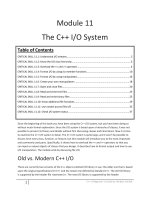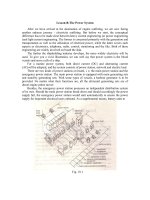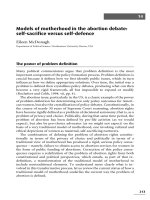System health self tuition
Bạn đang xem bản rút gọn của tài liệu. Xem và tải ngay bản đầy đủ của tài liệu tại đây (65.65 KB, 2 trang )
SYSTEM HEALTH (SELF-TUITION ASSIGNMENT)
Teacher
Dr. Yen Le, Department of Environmental Science, FNWI, RU
Background
A healthy ecosystem is active and dynamic (vigour), has sufficient counteractive
capacity (resilience) and maintains its organisation over time (metastability) while
allowing social and economic needs to be met by society (Vugteveen et al., 2006).
This sounds rather abstract, but ‘vigour’, ‘resilience’ and ‘organisation’ can be
reduced to measurable variables (indicators), which for the most part find origin in
system ecology. Also anthropogenic stress that arises from societal activities in the
system can be quantified.
Objectives
Students can adequately discuss the development and meaning of the
concept ‘Ecosystem Health’;
Students are able to indicate how the concept can be elaborated in
measurable variables and are aware of the knowledge gaps that are present
in the development of applications of the concept.
Instruction
Thoroughly read the article by Vugteveen et al. (2006). Next, define the terms below
and then answer the posed questions. For this assignment 3 hours have been
scheduled. Spend at least 1 hour on the definition of terms and the elaboration of the
questions.
Terms
Define the following terms:
• Organisation
• Resilience
• Vigour
• Condition indicator
• Stressor indicator
Questions
1.
Produce a short overview of the development of the concept of ‘Ecosystem
Health’ based on existing definitions and their features.
2.
Ecosystem Health and Biological Integrity are both normative concepts.
Suppose you are talking with two nature managers and both adhere to either one
of these concepts. Firstly, in what way do you think that their visions will coincide
or differ, and secondly what can be the consequences for management in
practice? Illustrate your answer in relation to the management of a nature
conservation area.
3.
Write down (at least three of) the most important features, or parts of
definition, for (River) Ecosystem Health.
4.
How does River System Health (RSH) conceptually relate to River Ecosystem
Health (REH)? Explain.
5.
What is meant by the ‘combined approach’ in relation to the measurement of
River Ecosystem Health? Explain.
6.
Explain how aspects of time and space (levels of scale) play a role in the
application and interpretation of system indicators, for example in relation to the
measurement of primary production in a river?
7.
Why is it generally easier to measure ‘stressor’ indicators than ‘condition’
indicators? Explain.
8.
a.
What are the advantages and disadvantages of developing a single
index (‘one value’) for Ecosystem Health?
b. What are the important issues that need to be considered when developing
such an index? Explain.
Product
Answers to the questions formulated above.
Discussion
• What is the contribution of Ecosystem Health within the context of
conservation and management of (eco)systems?
• What are the most important knowledge gaps in quantifying Ecosystem
Health?
• What is the meaning of the assessment approach proposed by Vugteveen et
al. for quantifying the effects of anthropogenic stress on ecosystems?
Literature
Vugteveen, P., R.S.E.W. Leuven, M.A.J. Huijbregts & H.J.R. Lenders, 2006.
Redefinition and elaboration of river ecosystem health: perspectives for river
management. Hydrobiologia.565(1), 289-308









